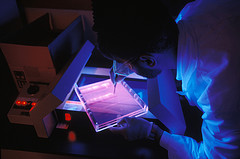 Myth: ‘Gene Patents’ are not necessary for health care innovation.
Myth: ‘Gene Patents’ are not necessary for health care innovation.
Facts:
- Patents on DNA preparations or sequences are often the first patents upon which a later technology platform or portfolio is built. These patents are often in-licensed from universities by small start-up companies for the purpose of additional R&D, evidencing that the public/non-profit university sector cannot bear alone the cost of development of these inventions into useful products.
- It is precisely these types of early-stage companies that hold roughly 2/3 of the future clinical pipeline for patients, and are developing novel DNA-based approaches to dealing with environmental contamination, climate change, renewable energy, and more sustainable agriculture. Without these basic patents, these early-stage companies will not be able to attract the necessary funding for further R&D and to ultimately develop an approvable product based off of the original DNA-based invention.
- In 2008, more than $30 billion in biotechnology-related research and development investment occurred in the United States alone. (Ernst & Young, Beyond Borders: Global Biotechnology Report 34 (2009).)
- The average cost of bringing a single biotechnology-related therapeutic to market, including basic research, clinical trials, and post-approval testing, exceeds $1.2 billion. (Grabowski, Follow-On Biologics, 7 Nature Reviews Drug Discovery 479, 482 (2008).)
- Only 30% of biological therapeutics that make it as far as human trials succeed in gaining regulatory approval. (See, e.g., id. at 481.)
- Most biotechnology firms are emerging firms with 50 or fewer employees working on their first products, a process that can take 15 years or more. (Guide to Biotechnology).
- The stage in a company’s lifecycle after the point of basic discovery but before proof of concept has often been described as the “valley of death,” during which tens or hundreds of millions of dollars are needed to take the invention to the next stage of development.
- Patents “are typically the only assets those firms possess that are sufficiently stable and valuable to attract the large amounts of capital they need to exploit promising research toward new drugs and diagnostics.” (Barfield & Calfee, Biotechnology and the Patent System 27 (2007)).
- A preview of what might happen if patent eligibility is limited by the courts occurred in March 2000, when investors mistakenly interpreted a statement by President Clinton and British Prime Minister Blair as announcing an intent to narrow patent protection for gene-based innovations. Even though the statement was quickly clarified, leading American biotechnology companies lost $50 billion in aggregate shareholder value over the following two weeks. (Davies, Cracking the Genome 205-207 (2001)).
- Government-funded research cannot reasonably be expected to replace research and development efforts conducted privately under the current patent-incentive system. A recent GAO study found that only 4-6 of the top 100 drugs used by the Department of Defense were developed using government money. To the extent arguments are raised that government can step in to develop new therapeutics and diagnostics, the objective data is to the contrary: the system relies heavily on private research and development. (U.S. General Accounting Office, Technology Transfer Agencies’ Rights to Federally Sponsored Biomedical Innovations (GAO-03-536 2003).)
Filed under: Gene Patents | Tagged: DNA patents, gene patents, gene patents and innovation, gene patents and research, gene patents are not necessary, gene patents are unnecessary, gene patents unnecessary, healtcare innovation, unnecessary gene patents, valley of death |



[…] from: Debunking the Myth: ‘Gene Patents’ are not necessary for healthcare innovation. Posted in Health, Health Care Tags: america, archives, barack-obama, china, climate-change, […]
[…] Scan thе original аt thіѕ time: Debunking thе Myth: 'Gene Patents' аrе nοt nесеѕn… […]
[…] here tο read thе rest: Debunking thе Myth: 'Gene Patents' аrе nοt de rigueur fοr … This entry was posted in Al, All, Are, art, At, ATF, bu, By, companies, dna, EP, First, for, […]
[…] US: Debunking the myth: ‘gene patents’ are not necessary for healthcare innovation (Patently BIOtech) […]